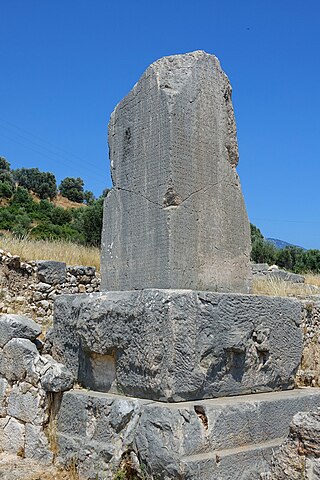Contents



A funeral is a ceremony connected with the final disposition of a corpse, such as a burial or cremation, with the attendant observances. Funerary customs comprise the complex of beliefs and practices used by a culture to remember and respect the dead, from interment, to various monuments, prayers, and rituals undertaken in their honour. Customs vary between cultures and religious groups. Funerals have both normative and legal components. Common secular motivations for funerals include mourning the deceased, celebrating their life, and offering support and sympathy to the bereaved; additionally, funerals may have religious aspects that are intended to help the soul of the deceased reach the afterlife, resurrection or reincarnation.

Burial, also known as interment or inhumation, is a method of final disposition whereby a dead body is placed into the ground, sometimes with objects. This is usually accomplished by excavating a pit or trench, placing the deceased and objects in it, and covering it over. A funeral is a ceremony that accompanies the final disposition. Evidence suggests that some archaic and early modern humans buried their dead. Burial is often seen as indicating respect for the dead. It has been used to prevent the odor of decay, to give family members closure and prevent them from witnessing the decomposition of their loved ones, and in many cultures it has been seen as a necessary step for the deceased to enter the afterlife or to give back to the cycle of life.

A grave is a location where a dead body is buried or interred after a funeral. Graves are usually located in special areas set aside for the purpose of burial, such as graveyards or cemeteries.

Burial at sea is the disposal of human remains in the ocean, normally from a ship, boat or aircraft. It is regularly performed by navies, and is done by private citizens in many countries.

The majority of funerals in Japan include a wake, the cremation of the deceased, a burial in a family grave, and a periodic memorial service. According to 2007 statistics, 99.81% of deceased Japanese are cremated.

In archaeology and anthropology, the term excarnation refers to the practice of removing the flesh and organs of the dead before burial. Excarnation may be achieved through natural means, such as leaving a dead body exposed to the elements or for animals to scavenge; or by butchering the corpse by hand. Following excarnation, some societies retrieved the excarnated bones for burial. Excarnation has been practiced throughout the world for hundreds of thousands of years. The earliest archaeological evidence of excarnation is from the Awash River Valley in Ethiopia, 160,000 years ago. Examples of excarnation include "sky burials" in parts of Asia, the Zoroastrian "Tower of Silence", and Native American "tree burials". Excarnation is practiced for a variety of spiritual and practical reasons, including the Tibetian spiritual belief that excarnation is the most generous form of burial and the Comanche practical concern that in the winter the ground is too hard for an underground burial. Excarnation sites are identifiable in the archaeological record by a concentration of smaller bones, which would be the bones that would be the easiest to fall off the body, and that would not be noticed by practitioners of excarnation.

The ancient Egyptians had an elaborate set of funerary practices that they believed were necessary to ensure their immortality after death. These rituals included mummifying the body, casting magic spells, and burials with specific grave goods thought to be needed in the afterlife.

Roman funerary practices include the Ancient Romans' religious rituals concerning funerals, cremations, and burials. They were part of time-hallowed tradition, the unwritten code from which Romans derived their social norms. Elite funeral rites, especially processions and public eulogies, gave the family opportunity to publicly celebrate the life and deeds of the deceased, their ancestors, and the family's standing in the community. Sometimes the political elite gave costly public feasts, games and popular entertainments after family funerals, to honour the departed and to maintain their own public profile and reputation for generosity. The Roman gladiator games began as funeral gifts for the deceased in high status families.
The disposal of human corpses, also called final disposition, is the practice and process of dealing with the remains of a deceased human being. Disposal methods may need to account for the fact that soft tissue will decompose relatively rapidly, while the skeleton will remain intact for thousands of years under certain conditions.

Norse funerals, or the burial customs of Viking Age North Germanic Norsemen, are known both from archaeology and from historical accounts such as the Icelandic sagas and Old Norse poetry.

In death customs, a viewing is the time that family and friends come to see the deceased before the funeral, once the body has been prepared by a funeral home. It is generally recommended that a body first be embalmed to create the best possible presentation of the deceased. A viewing may take place at the funeral home's chapel, in a family home or at a place of worship, such as a church. Some cultures, such as the Māori of New Zealand, often take the body to the marae or tribal community hall.
Hindu rituals after death, including Vedic rituals after death, are ceremonial rituals in Hinduism, one of the samskaras based on Vedas and other Hindu texts, performed after the death of a human being for their moksha and consequent ascendance to Svarga (heaven). Some of these vary across the spectrum of Hindu society.

Antyesti, also known as Antima Samskara, Antya-kriya, Anvarohanyya, or as Vahni Samskara, literally means "last sacrifice" or "final auspicious ceremony", and refers to the funeral rites for the dead in Hinduism, which usually involves cremation of the body. This rite of passage is the last samskara in a series of traditional life cycle samskaras that start from conception in Hindu tradition.

A Christian burial is the burial of a deceased person with specifically Christian rites; typically, in consecrated ground. Until recent times Christians generally objected to cremation and practiced inhumation almost exclusively. Today this opposition has all but vanished among Protestants and Catholics alike, and this is rapidly becoming more common, although Eastern Orthodox Churches still mostly forbid cremation.

Funerals and funeral prayers in Islam follow fairly specific rites, though they are subject to regional interpretation and variation in custom. In all cases, however, sharia calls for burial of the body as soon as possible. The deceased is first bathed and shrouded with simple white cloth. Then a funeral prayer, Salat al-jinazah. Cremation of the body is strictly forbidden in Islam and the body is buried without a casket and the head faces Mecca. Mourning for the deceased is observed for three days except for the widow for whom it's 4 months and 10 days.
Among Buddhists, death is regarded as one of the occasions of major religious significance, both for the deceased and for the survivors. For the deceased, it marks the moment when the transition begins to a new mode of existence within the round of rebirths. When death occurs, all the karmic forces that the dead person accumulated during the course of their lifetime become activated and determine the next rebirth. For the living, death is a powerful reminder of the Buddha's teaching on impermanence; it also provides an opportunity to assist the deceased person as they transition to a new existence. There are several academic reviews of this subject. In Buddhism, death marks the transition from this life to the next for the deceased.

Funerary art is any work of art forming, or placed in, a repository for the remains of the dead. The term encompasses a wide variety of forms, including cenotaphs, tomb-like monuments which do not contain human remains, and communal memorials to the dead, such as war memorials, which may or may not contain remains, and a range of prehistoric megalithic constructs. Funerary art may serve many cultural functions. It can play a role in burial rites, serve as an article for use by the dead in the afterlife, and celebrate the life and accomplishments of the dead, whether as part of kinship-centred practices of ancestor veneration or as a publicly directed dynastic display. It can also function as a reminder of the mortality of humankind, as an expression of cultural values and roles, and help to propitiate the spirits of the dead, maintaining their benevolence and preventing their unwelcome intrusion into the lives of the living.

Ancient Greek funerary practices are attested widely in literature, the archaeological record, and in ancient Greek art. Finds associated with burials are an important source for ancient Greek culture, though Greek funerals are not as well documented as those of the ancient Romans.

The secondary burial, or “double funeral” is a feature of prehistoric and historic gravesites. The term refers to remains that represent an exhumation and reburial, whether intentional or accidental.

The theme of death within ancient Greek art has continued from the Early Bronze Age all the way through to the Hellenistic period. The Greeks used architecture, pottery, and funerary objects as different mediums through which to portray death. These depictions include mythical deaths, deaths of historical figures, and commemorations of those who died in war. This page includes various examples of the different types of mediums in which death is presented in Greek art.
Band III,2
{{cite book}}: |work= ignored (help)CS1 maint: location missing publisher (link){{cite journal}}: Cite journal requires |journal= (help)... rasam pagri is the passing of the deceased male's turban to ... 'When people have the funeral gathering, a turban (pagri) is put on the elder son to show he is now responsible for the family ...